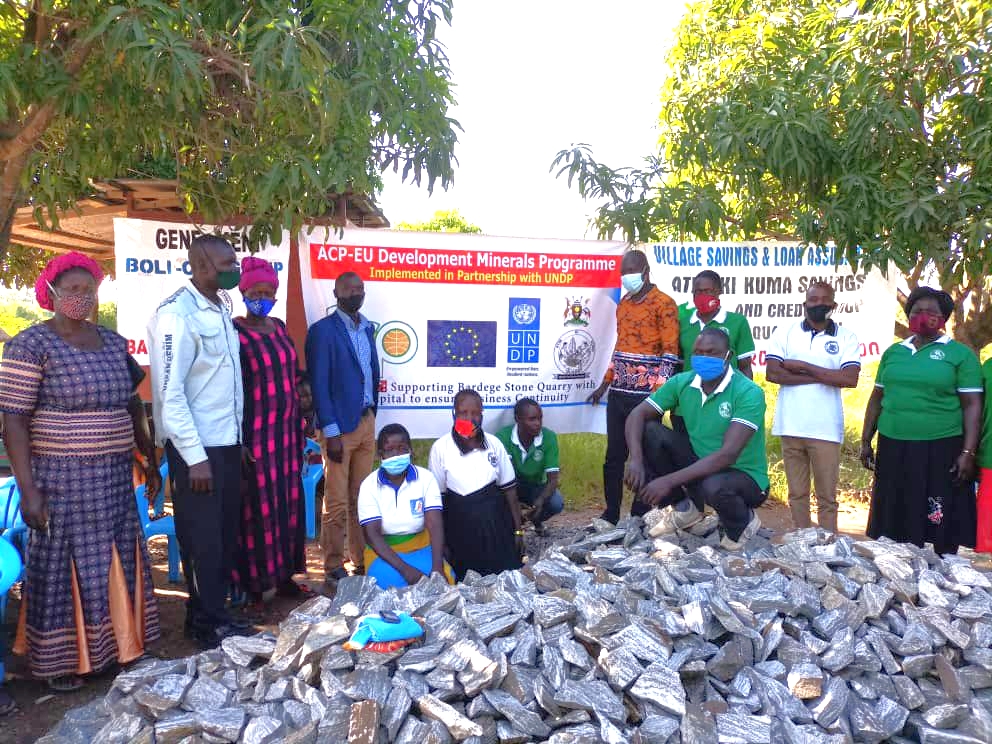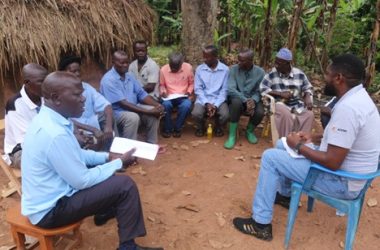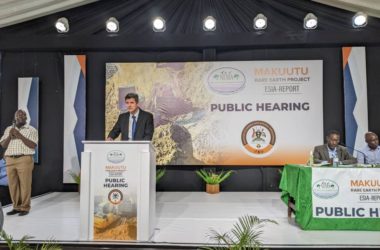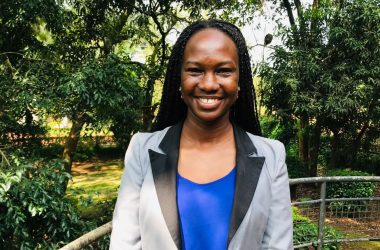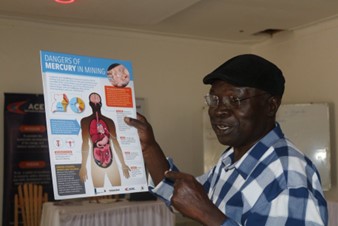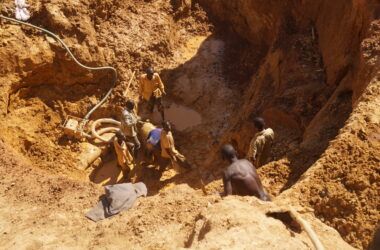In May 2021, Atim Ki Kuma association and Apila stone quarry in Gulu and Lira districts respectfully, received a grant worth five thousand US dollars ($5000) from United Nations Development Programme (UNDP), which aimed at supporting beneficiaries for Improvement of Workplace Health and Safety and Revitalization of Business operations in the face of covid19.
The grant was welcome and timely as miners at that time were experiencing adverse impacts of covid19. Covid19 hit the already vulnerable miners, and made working conditions tougher than they already were.
Direct beneficiaries of the project from Atim Ki Kuma association were 440, while indirect beneficiaries were 1760. The grant also entailed aspects of formalization, where grantees were tasked to register associations from the surrounding sites at district level, to enable such sites operate on a formal basis, known by their District local leaders.
Both associations have since completed implementation of the grant requirements, and have registered great progress since the money was availed to them.
Before the grant, women from Atim Ki Kuma worked in shifts due to the scarcity of harmers at the site. This greatly affected production. Some women, who could not afford sledge hammers had to wait for the owners to rest before they could begin to work. Bardege stone quarry, where Atim Ki Kuma association operates therefore produced only 2-3 trucks a day. At this point, about 90 women worked at a time. Ever since 327 sledge hammers were availed to them, Bardege stone quarry produces 6-7 trucks of aggregates a day, with 191 women working at the same time. This has in turn boosted sales for the quarry as opposed to before the equipment was provided.
Before harmers were availed, women made UGX 1,000 to UGX 2,000 each per day. The women now make UGX 4,000 to UGX 5,000 per day, thanks to the availability of tools.
Due to the poor sales before the grant, the Village Savings and Loans Associations (VSLAs) at the quarry got depleted. The quarry has three VSLAs, all of which were depleted as a result of tougher working conditions caused by the pandemic. The project facilitated the three groups with funds worth UGX 2,113,000 for each group. The group leaders developed a payment strategy, enabling miners to borrow and pay back according to the agreed upon structure.
Before the grant, only a few miners were qualified to borrow money due to the limited funds. At the moment, over 200 people are able to borrow from the VSLA groups. The money borrowed usually caters for production costs like; paying crushers, buy hardcore rocks from extractors, paying trucks to transport hardcore among other production costs.
Lira district, Apila quarry
Before the grant, only seven (7) sledge hammers were available for hire by all the 100 ASMs at Apila stone quarry. This limited production to 3-5 tonnes per day due to the unavailability of tools. The project provided 10 (20lbs), 15 (18lbs) sledge hammers, 60 (4lbs), 15 (2lbs) hand hammers which were utilized by the 100 Artisanal miners at Apila. Production shot up to 15-20 tonnes per day after the project commenced. Miners at the quarry report that this was the first time they were hitting such levels of production.
Miners made UGX 2,000 to 4,000 each per day before the grant due to the limited number of tools at the quarry. Miners are currently making UGX 5,000 to 10,000 or more, due to the constantly available tools that allow for an increased production and hence increased sells.
The availability of tools increased the number of workers, working at the same time in Apila. From 100-120 women and 30-50 men, Apila stone quarry currently employs 200-300 women and 70-100men working at the same time.
Miner testimonies
Geoffrey Otim, a stone crasher from Apila stone quarry reports that as a result of adequate production, he has been able to supply over 1000 tonnes of aggregates. He also attests to being more visible and attracting big market ever since the grant. “I have now become well known for providing the best aggregates here in Lira. So many new people have been calling me to supply them with aggregates.” He says.
Florence Amollo, a mother of two children has been able to fully clear their school fees in private school. Florence has also been able to employ 4 women to help her crush stones from the profit she made ever since the tools were provided, compared to before when she had to crush the stones herself. Florence pointed out that before the grant, she was barely making enough to provide for home consumption.
Lalam Consi from Bardege quarry, was able to borrow money from her VSLA group-atim ki kuma four times. She borrowed UGX 120,000 the first time which she used to top up and purchase a truck of hard core at UGX 240,000. From this, she crushed into small aggregates and was able to make a profit of UGX 146,000 where she was able to pay back her UGX 120,000 loan. She then borrowed UGX 160,000 and bought aggregates eighty jerry cans of aggregates at UGX 2,000 each which she sold at UGX 2500 each. When she paid back the money, she was forced to borrow UGX140, 000 which partly funded a surgery of her brother, whom she was happy to have saved due to the access to funds from the grant funded VSLA she is attached to. She then refunded this money and borrowed UGX 200,000 which she used to purchase 100 jerry cans of aggregates and hopes to refund the loan and retain a profit after selling these aggregates. With this money, she has also been able to buy school requirements for her daughter who studies in a primary school.
Ouma David and his wife from Bardege stone quarry, attached to Gene Keni VSLA group were able to borrow money two times. The first loan was invested in his wife’s retail business, which has since brought many returns and has paid the loan. David then took a loan and purchased a truck of hardcore, which produced two trucks of small aggregates. He paid back his loan from the profit he made after selling the two trucks. This profit also enabled him purchase materials like eucalyptus, grass for constructing an extra hut for his children. Before, he and his wife shared the same hut with the children, but after profiting from the sale of his aggregates, he has been able to build his children their own hut. He plans to borrow more money, and from the profit of aggregates, buy iron sheets as well as bricks to construct a two roomed permanent house for his family.
Comment from UNDP official
When reached, an official from the development mineral programme noted that the project beneficiaries had been very proactive and intentional, delivering beyond the scope of the intervention. “They have been advocates and champions in documenting value of the programme.” She also pointed out that the Local Governments in the two districts were aware of the activities and this would help with sustainability of the Programme. The official further mentioned the acquired skills as ASMs demonstrated better reporting and writing skills as they were able to communicate results. “They will be able to manage more partnerships in the future.”

